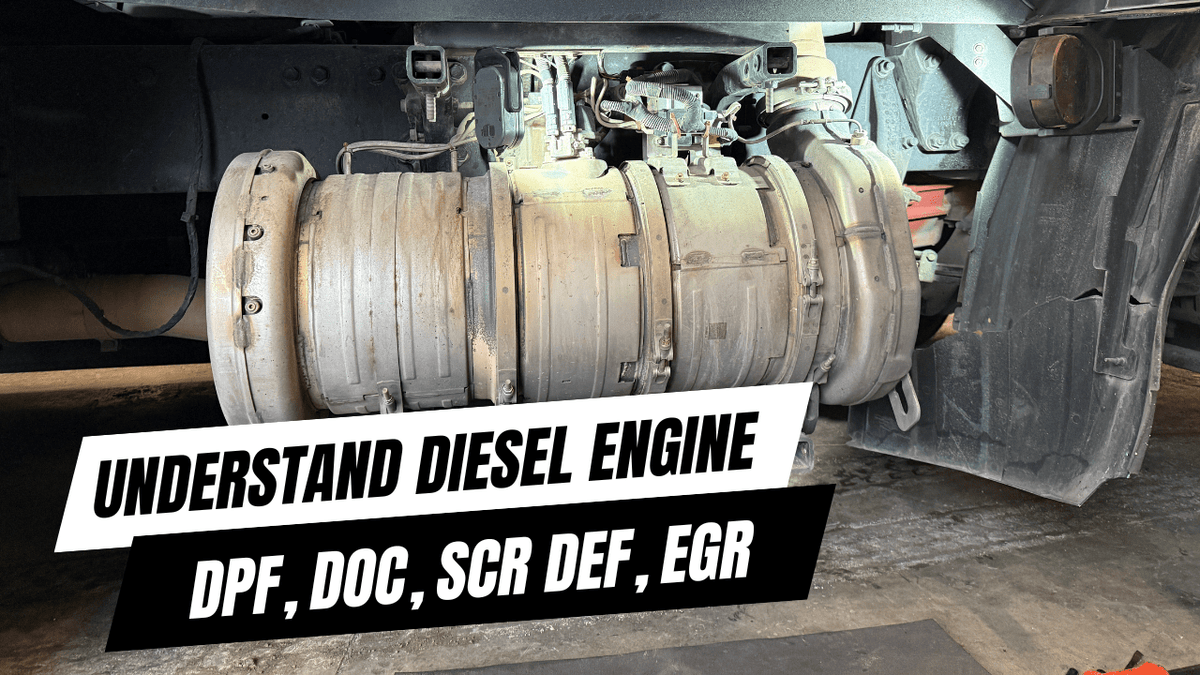
Understanding DPF DOC SCR EGR: Protecting Your Diesel Engine
|
Time to read 6 min
|
Time to read 6 min
In the world of diesel engines, terms like DPF, DOC, SCR, and EGR are often thrown around, but what do they really mean for you and your truck? This blog will break down these essential components and their impact on your engine's performance and longevity, so you can keep that investment running smoothly.
Diesel emissions control is crucial for modern diesel engines. As regulations tighten, understanding the systems in place becomes essential. The primary goal is to minimize harmful emissions while maintaining engine performance. Key technologies—EGR, DPF, and SCR—work together to achieve this balance.
There are two major emissions that diesel engines produce: Nitrogen Oxides (NOx) and Diesel Particulate Matter (DPM). NOx emissions arise from high-temperature combustion and contribute significantly to air pollution. On the other hand, DPM, often visible as black smoke, consists of soot from partially burned fuel.
Exhaust Gas Recirculation (EGR) is a technique used to reduce NOx emissions. It works by recirculating a portion of the exhaust back into the engine's intake. This process cools the combustion temperature, thereby reducing NOx formation.
The EGR valve regulates how much exhaust gas is recirculated based on engine conditions. While EGR effectively lowers NOx, it can lead to increased soot production due to less efficient combustion.
The Diesel Particulate Filter (DPF) plays a vital role in trapping DPM. Acting like a fine mesh, it captures soot particles from the exhaust before they exit the tailpipe. While effective initially, the DPF can become clogged over time, necessitating regeneration.
Regeneration is the process of burning off accumulated soot to restore filter functionality. However, factors like driving conditions can hinder regeneration, leading to reduced engine performance.
Regeneration involves raising the temperature of the DPF to about 1100°F (600°C) to incinerate soot. This process can be passive or active. In passive regeneration, the heat generated during normal driving is sufficient. Active regeneration, however, requires additional fuel injection to achieve the necessary temperatures.
Failing to complete the regeneration process can result in significant back pressure, impacting engine efficiency and leading to costly repairs. Regular maintenance and understanding your driving patterns can help mitigate these issues.
Maintaining the DPF is crucial for optimal engine performance. Regular cleaning and monitoring can prevent costly failures. However, if the DPF becomes too clogged, replacement can be extremely expensive, sometimes exceeding $8,000.
How to tell the DPF is clogged:
Investing in preventive measures can save you from unexpected expenses down the road.
Soot not only clogs the DPF but also contaminates engine oil. This contamination can lead to premature wear of critical engine components, including bearings and cylinder walls. The abrasive nature of soot contributes to engine damage over time.
Additionally, soot buildup can block oil passages, reducing lubrication. This can escalate wear and lead to catastrophic engine failure if not addressed promptly. Regular oil changes and high-quality filters can help manage soot levels effectively.
Selective Catalytic Reduction (SCR) and Diesel Exhaust Fluid (DEF) represent a significant shift in diesel emissions control. These technologies address the challenge of nitrogen oxides (NOx) emissions without compromising engine performance. By introducing DEF into the exhaust stream, SCR systems convert harmful NOx into harmless nitrogen and water vapor. This not only meets stringent EPA regulations but also enhances the efficiency of diesel engines.
DEF is primarily composed of urea and water, and it plays a crucial role in the SCR process. As diesel engines operate, the SCR system injects DEF into the exhaust, where it reacts with NOx in the presence of a catalyst. This chemical reaction transforms NOx into harmless substances, making it a game-changer for diesel vehicle owners.
Keeping DEF levels topped off is critical for the proper functioning of SCR systems. When DEF levels drop below a certain threshold, your vehicle will alert you with a warning light. Ignoring this warning can lead to severe consequences, including engine limp mode, which restricts speed to a crawl.
Additionally, if DEF runs out completely, your vehicle may not restart until the fluid is replenished. Regularly checking and maintaining DEF levels not only ensures compliance with emissions standards but also keeps your engine running smoothly, preventing unnecessary downtime.
Integrating SCR and DEF into your diesel engine setup has numerous benefits. One of the most significant advantages is the ability to optimize combustion temperatures. By reducing the reliance on EGR for NOx control, SCR allows for more efficient combustion, which translates to improved power and fuel economy.
Moreover, cleaner emissions mean less soot production, which ultimately prolongs the life of critical engine components. With reduced back pressure from the exhaust system, your engine can operate more efficiently, leading to enhanced performance and longevity.
To safeguard your diesel engine from the adverse effects of emissions control technologies, consider implementing the following recommendations:
You will need some type of software to manually perform a force regen. We highly recommend truck owners explore OTR Performance Diagnostic to perform a forced regen.
Understanding the complexities of DPF, DOC, SCR, and EGR is vital for any diesel engine owner. The introduction of SCR and DEF technologies has transformed diesel emissions control, making it more effective and less detrimental to engine performance. However, these systems require diligent maintenance and care to function optimally.
By adhering to the recommendations outlined above, you can protect your investment and enjoy the benefits of a well-maintained diesel engine for years to come.
DEF is used in conjunction with SCR to reduce NOx emissions from diesel engines.
Your vehicle will display a warning light when DEF levels are low, prompting you to refill it.
If DEF is depleted, your vehicle may enter limp mode, restricting speed until the fluid is replenished.
Regular maintenance of the DPF prevents clogging and back pressure, which can negatively impact engine efficiency and performance.
It's crucial to use DEF that meets ISO 22241 standards to ensure compatibility and effectiveness.



